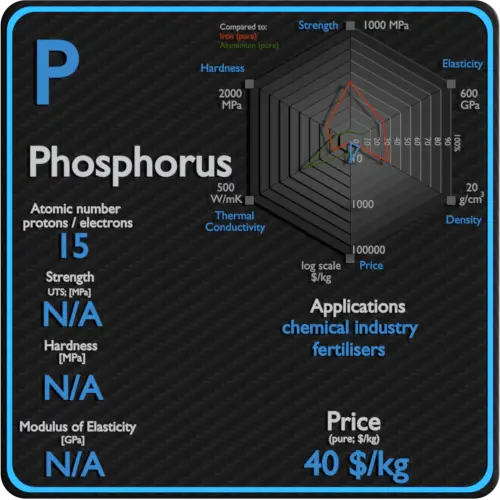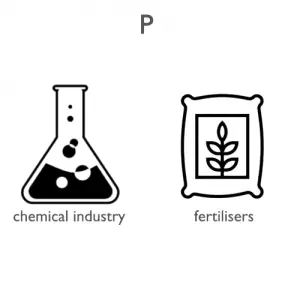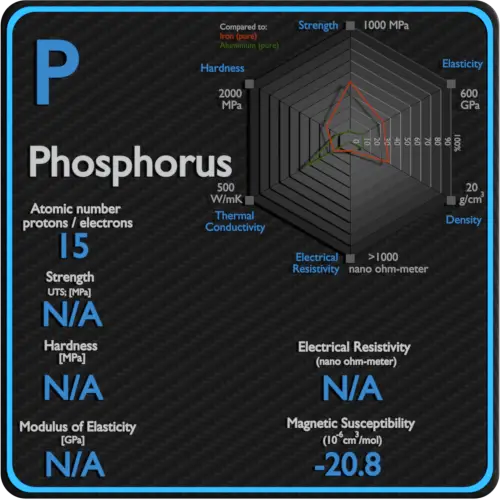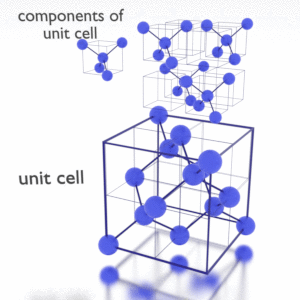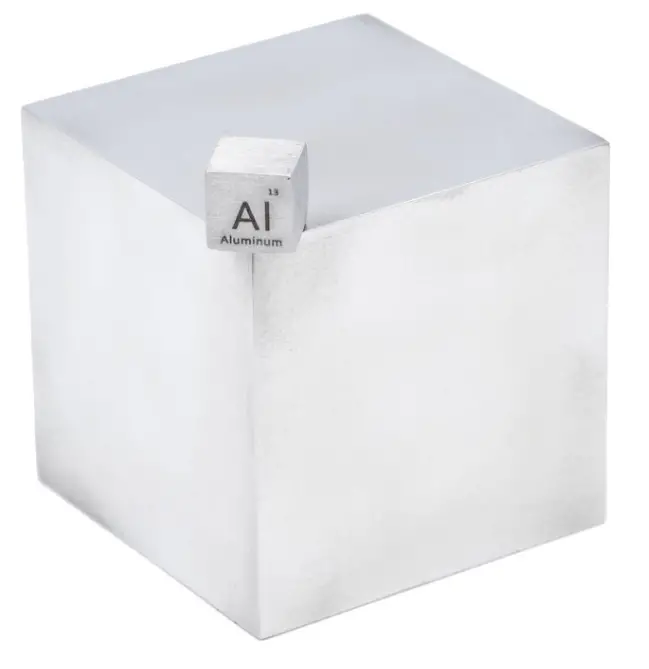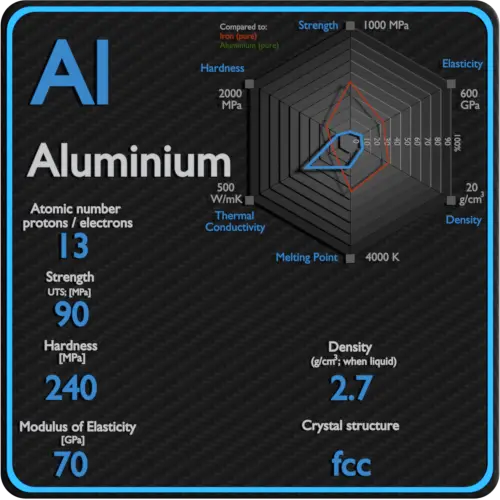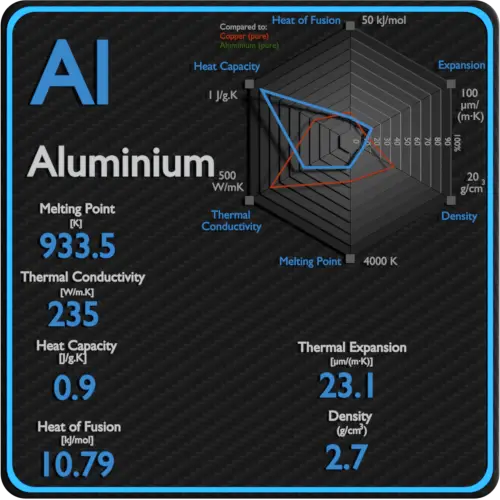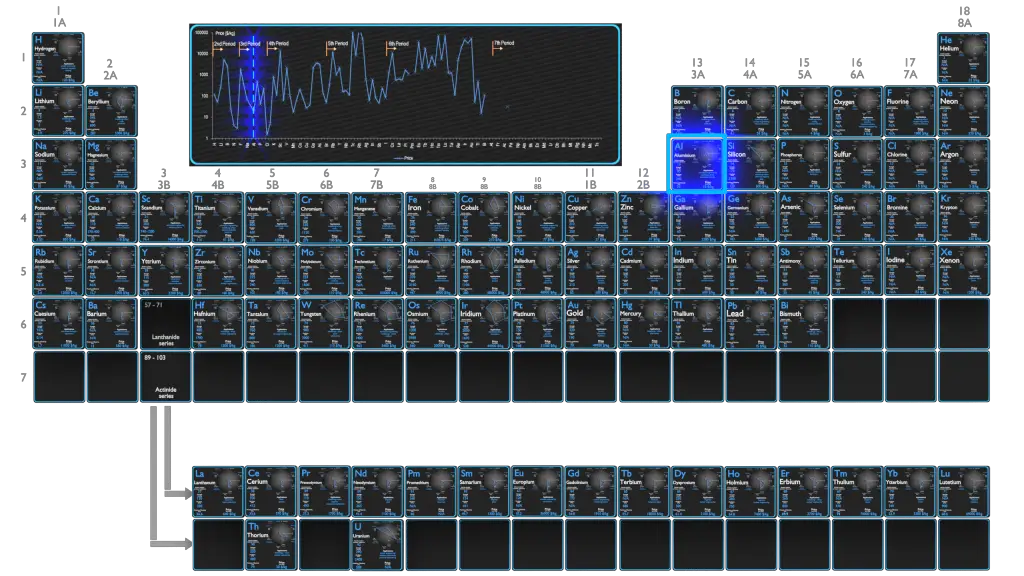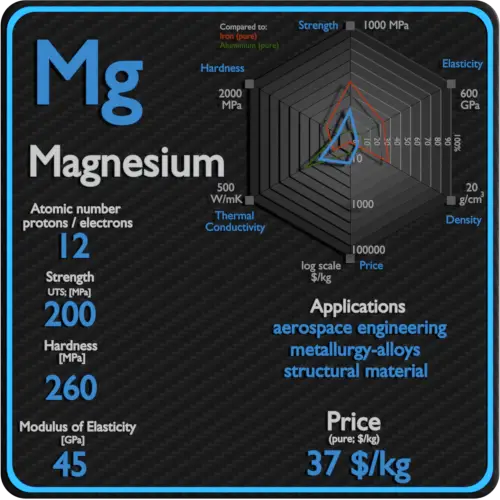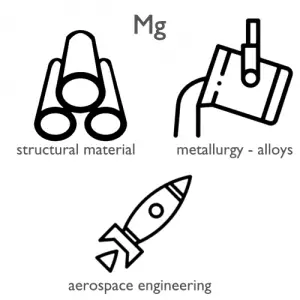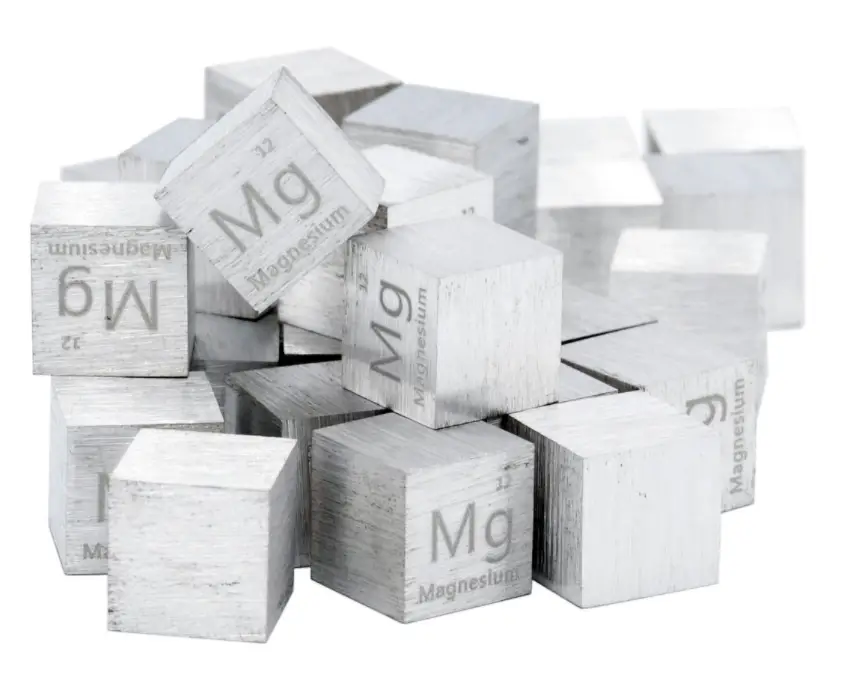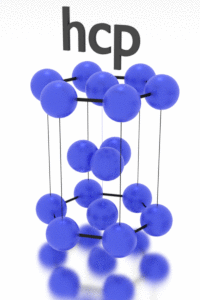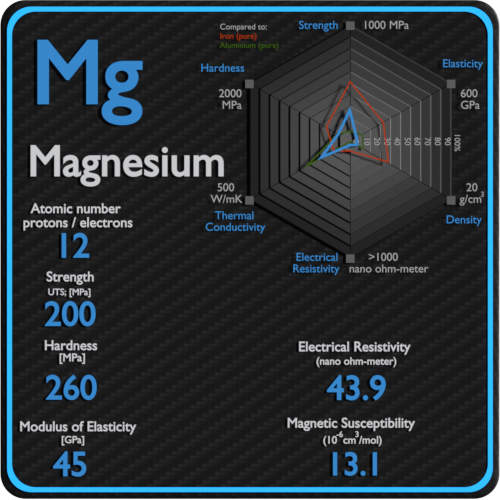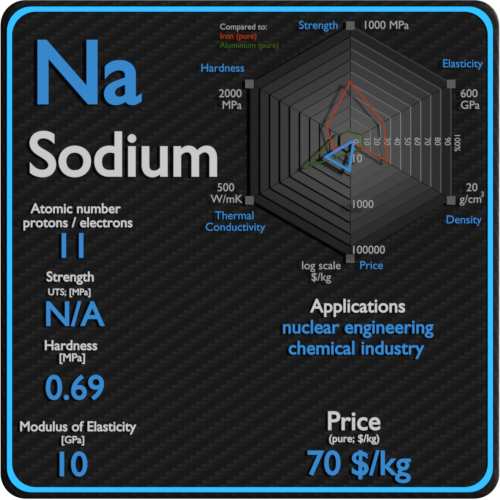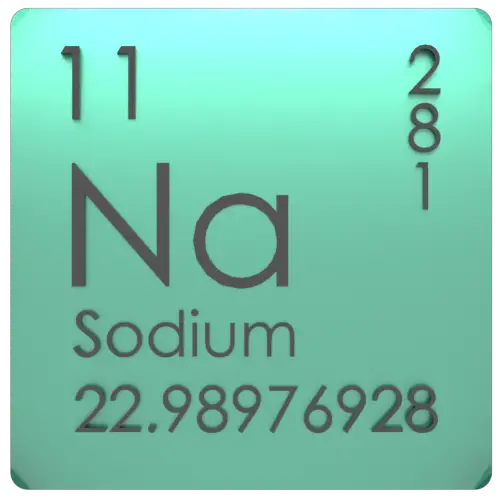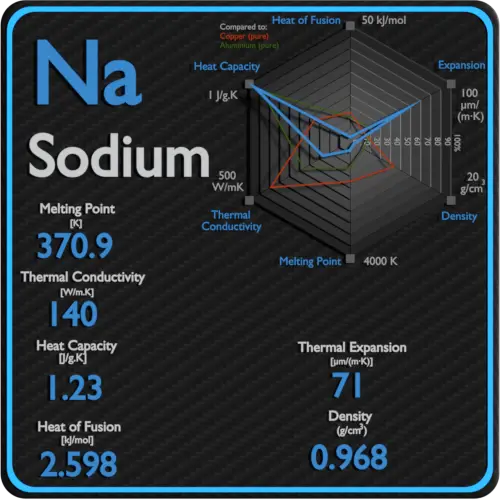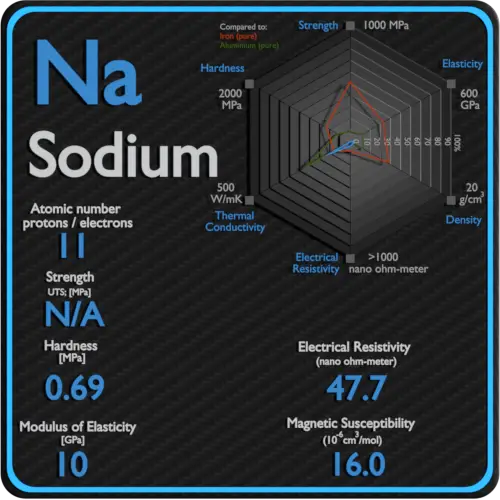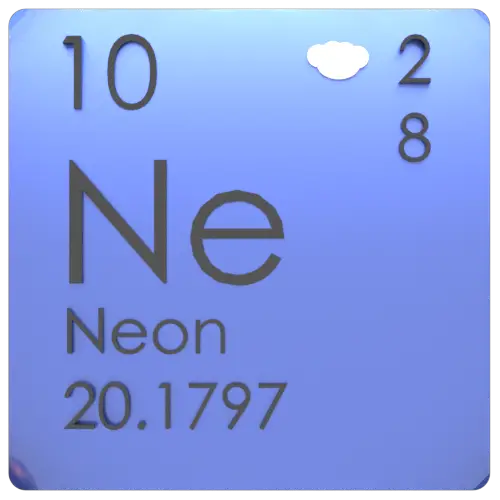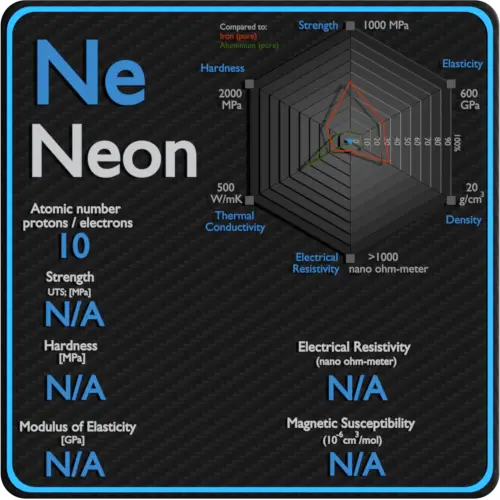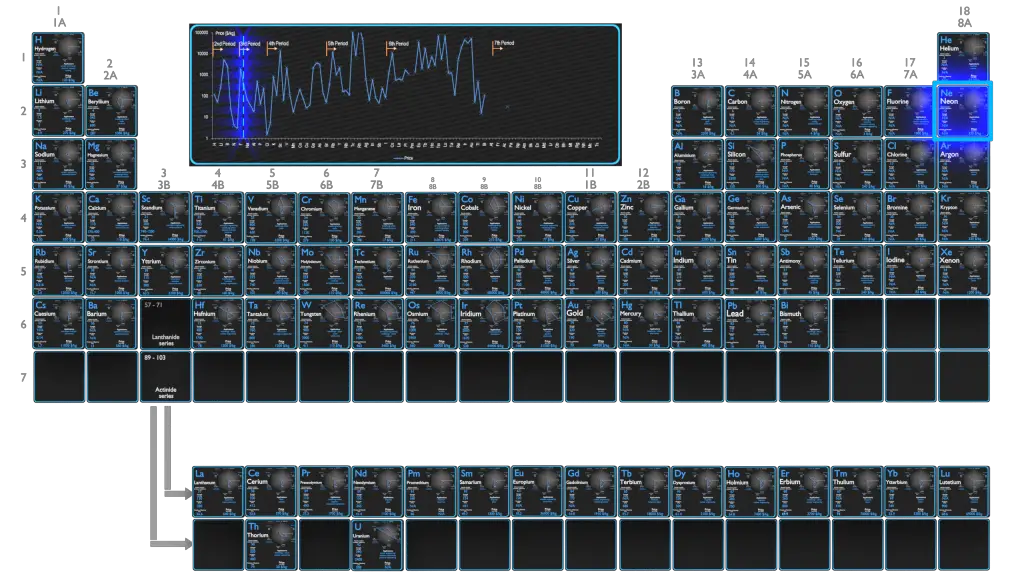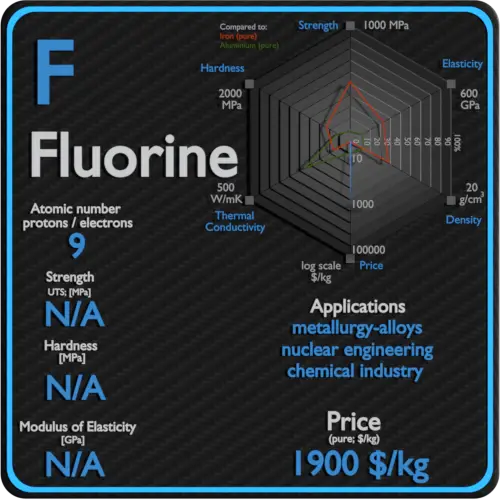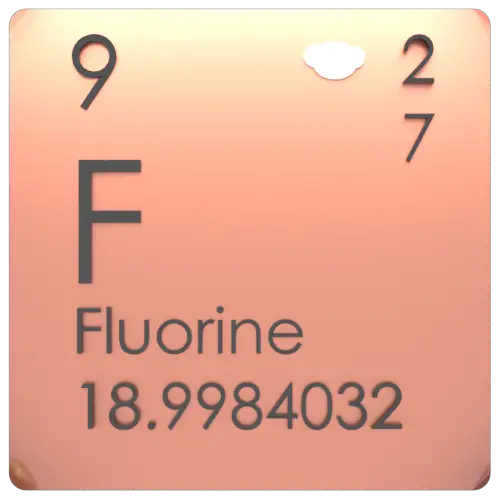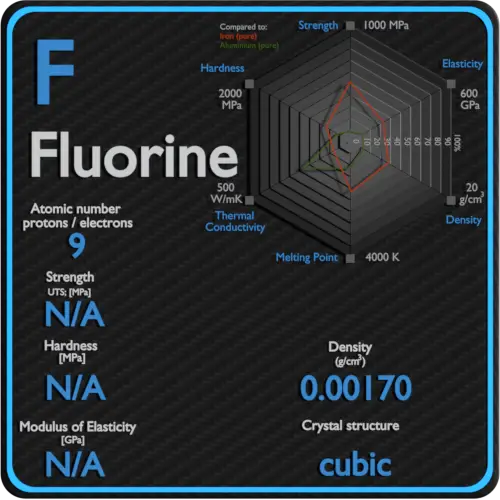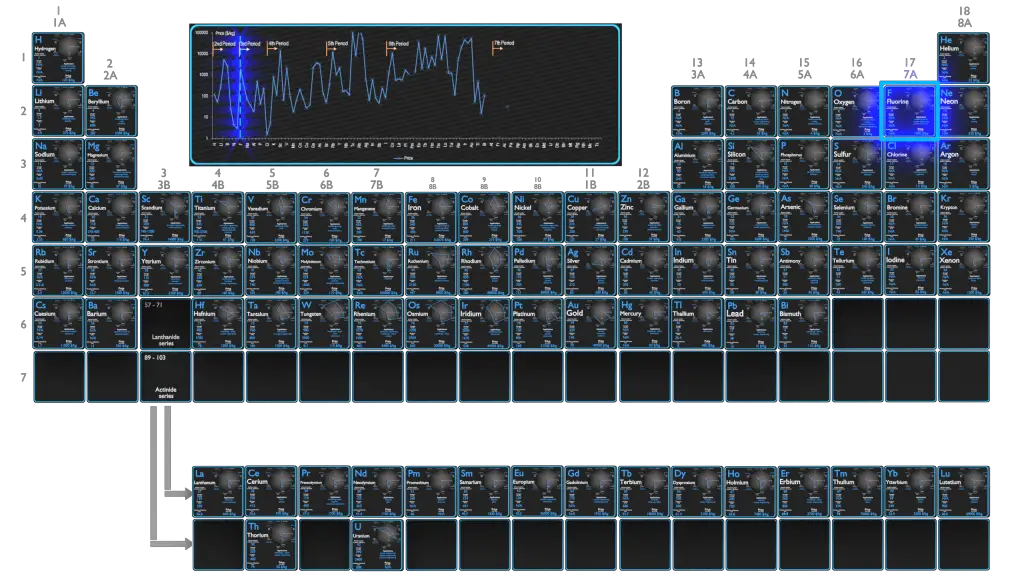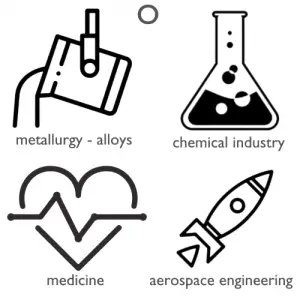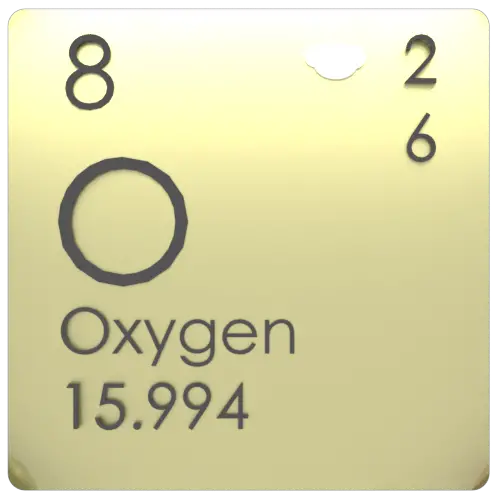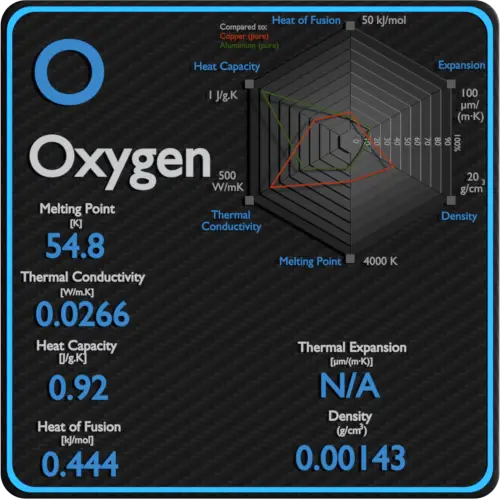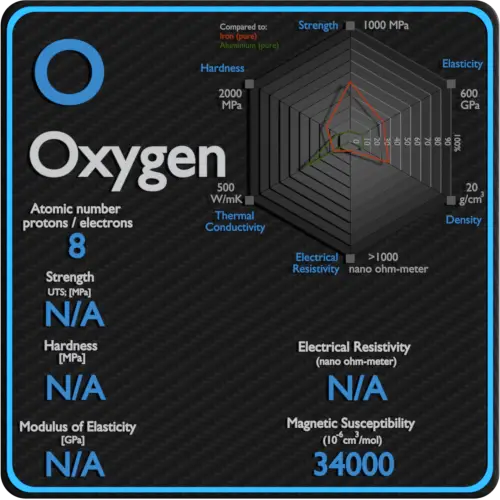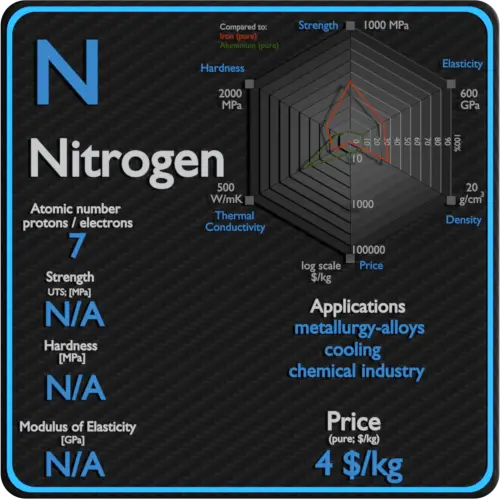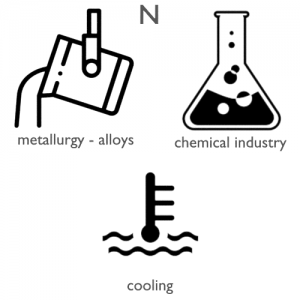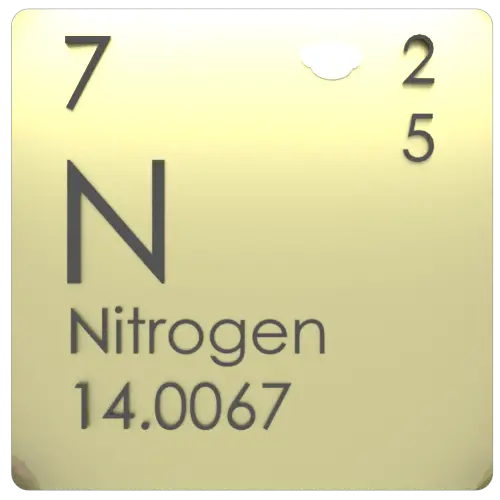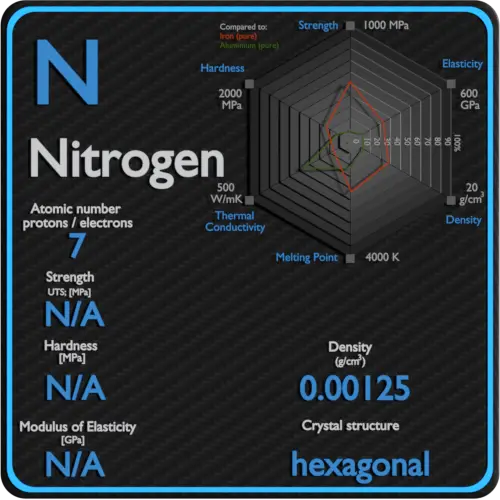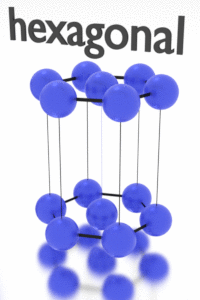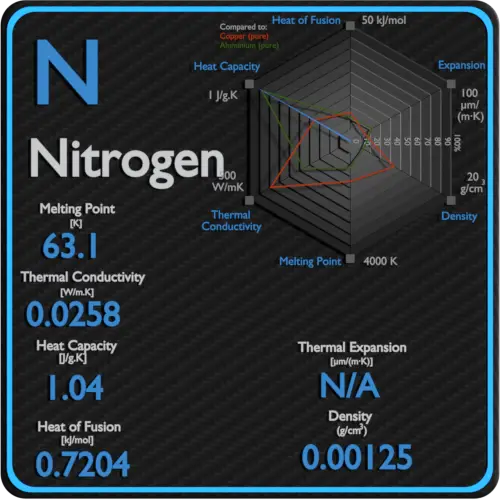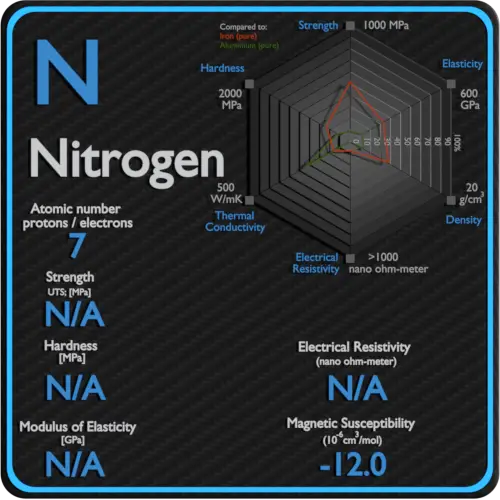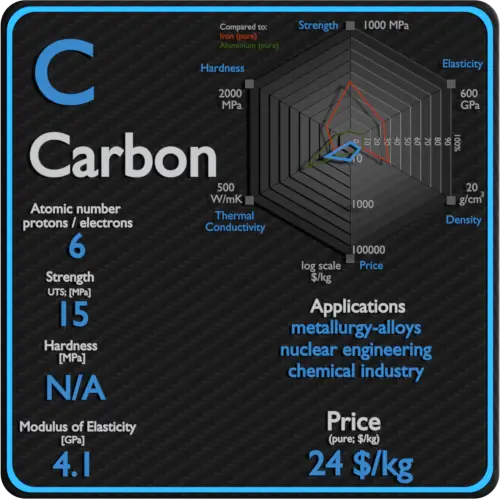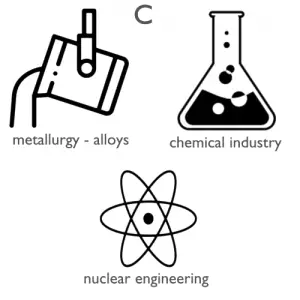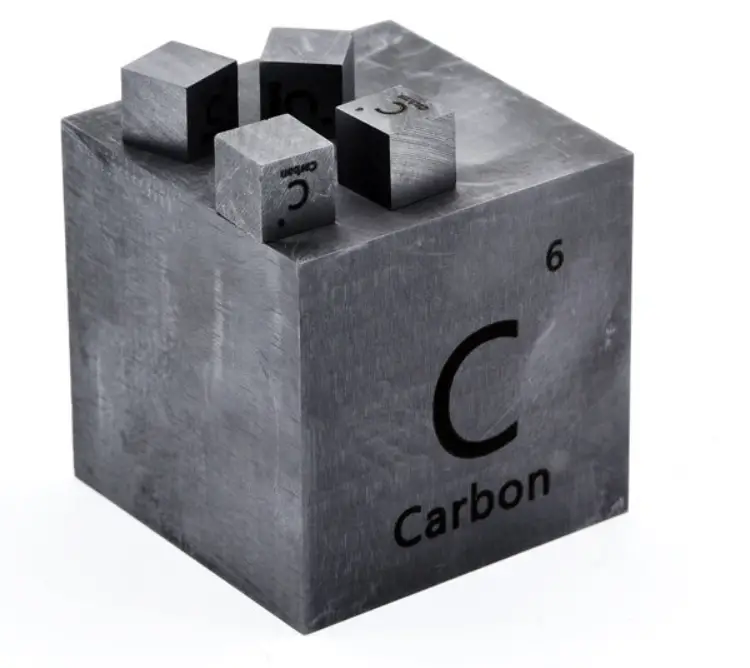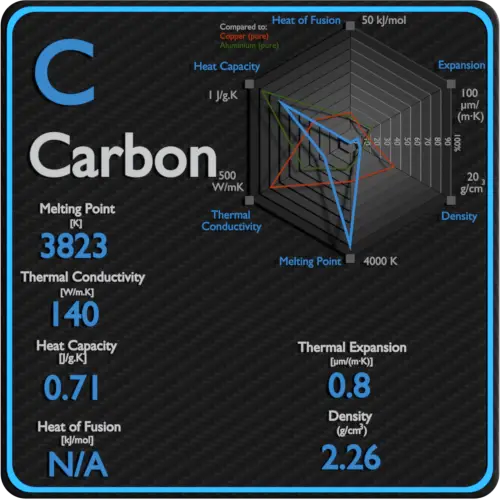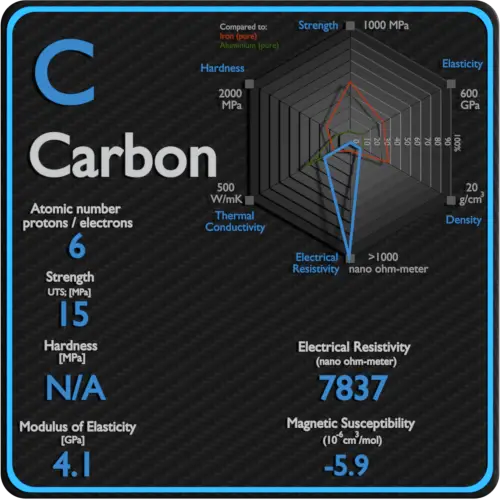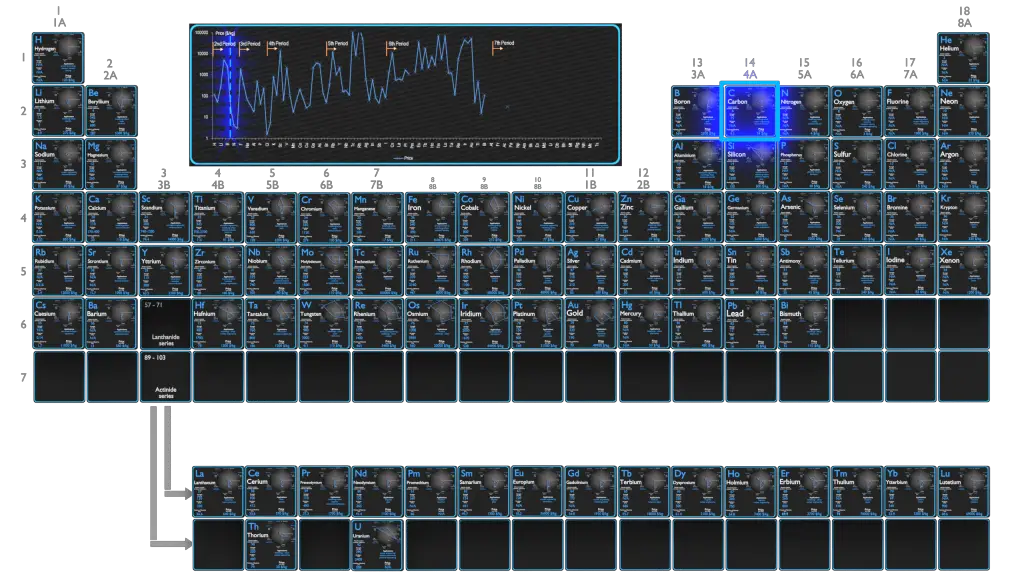About Phosphorus
As an element, phosphorus exists in two major forms—white phosphorus and red phosphorus—but because it is highly reactive, phosphorus is never found as a free element on Earth. At 0.099%, phosphorus is the most abundant pnictogen in the Earth’s crust.
Summary
| Element | Phosphorus |
| Atomic number | 15 |
| Element category | Non Metal |
| Phase at STP | Solid |
| Density | 1.823 g/cm3 |
| Ultimate Tensile Strength | N/A |
| Yield Strength | N/A |
| Young’s Modulus of Elasticity | N/A |
| Mohs Scale | 0.5 |
| Brinell Hardness | N/A |
| Vickers Hardness | N/A |
| Melting Point | 44.1 °C |
| Boiling Point | 280 °C |
| Thermal Conductivity | 0.235 W/mK |
| Thermal Expansion Coefficient | — µm/mK |
| Specific Heat | 0.77 J/g K |
| Heat of Fusion | 0.657 kJ/mol |
| Heat of Vaporization | 51.9 kJ/mol |
| Electrical resistivity [nanoOhm meter] | — |
| Magnetic Susceptibility | −20.8e-6 cm^3/mol |
Applications of Phosphorus
Phosphorus is an essential plant nutrient (the most often limiting nutrient, after nitrogen), and the bulk of all phosphorus production is in concentrated phosphoric acids for agriculture fertilisers, containing as much as 70% to 75% P2O5. The vast majority of phosphorus compounds mined are consumed as fertilisers. Phosphate is needed to replace the phosphorus that plants remove from the soil, and its annual demand is rising nearly twice as fast as the growth of the human population. Other applications include organophosphorus compounds in detergents, pesticides, and nerve agents.
Production and Price of Phosphorus
Raw materials prices change daily. They are primarily driven by supply, demand and energy prices. In 2019, prices of pure Phosphorus were at around 40 $/kg.
Most production of phosphorus-bearing material is for agriculture fertilisers. For this purpose, phosphate minerals are converted to phosphoric acid. It follows two distinct chemical routes, the main one being treatment of phosphate minerals with sulfuric acid. The other process utilises white phosphorus, which may be produced by reaction and distillation from very low grade phosphate sources. Peak phosphorus is a concept to describe the point in time when humanity reaches the maximum global production rate of phosphorus as an industrial and commercial raw material. The predominant source of phosphorus in modern times is phosphate rock (as opposed to the guano that preceded it).
Source: www.luciteria.com
Mechanical Properties of Phosphorus
Strength of Phosphorus
In mechanics of materials, the strength of a material is its ability to withstand an applied load without failure or plastic deformation. Strength of materials basically considers the relationship between the external loads applied to a material and the resulting deformation or change in material dimensions. In designing structures and machines, it is important to consider these factors, in order that the material selected will have adequate strength to resist applied loads or forces and retain its original shape. Strength of a material is its ability to withstand this applied load without failure or plastic deformation.
For tensile stress, the capacity of a material or structure to withstand loads tending to elongate is known as ultimate tensile strength (UTS). Yield strength or yield stress is the material property defined as the stress at which a material begins to deform plastically whereas yield point is the point where nonlinear (elastic + plastic) deformation begins.
See also: Strength of Materials
Ultimate Tensile Strength of Phosphorus
Ultimate tensile strength of Phosphorus is N/A.
Yield Strength of Phosphorus
Yield strength of Phosphorus is N/A.
Modulus of Elasticity of Phosphorus
The Young’s modulus of elasticity of Phosphorus is N/A.
Hardness of Phosphorus
In materials science, hardness is the ability to withstand surface indentation (localized plastic deformation) and scratching. Brinell hardness test is one of indentation hardness tests, that has been developed for hardness testing. In Brinell tests, a hard, spherical indenter is forced under a specific load into the surface of the metal to be tested.
Brinell hardness of Phosphorus is approximately N/A.
The Vickers hardness test method was developed by Robert L. Smith and George E. Sandland at Vickers Ltd as an alternative to the Brinell method to measure the hardness of materials. The Vickers hardness test method can be also used as a microhardness test method, which is mostly used for small parts, thin sections, or case depth work.
Vickers hardness of Phosphorus is approximately N/A.
Scratch hardness is the measure of how resistant a sample is to permanent plastic deformation due to friction from a sharp object. The most common scale for this qualitative test is Mohs scale, which is used in mineralogy. The Mohs scale of mineral hardness is based on the ability of one natural sample of mineral to scratch another mineral visibly.
Phosphorus is has a hardness of approximately 0.5.
See also: Hardness of Materials
Phosphorus – Crystal Structure
A possible crystal structure of Phosphorus is body-centered cubic structure.
In metals, and in many other solids, the atoms are arranged in regular arrays called crystals. A crystal lattice is a repeating pattern of mathematical points that extends throughout space. The forces of chemical bonding causes this repetition. It is this repeated pattern which control properties like strength, ductility, density, conductivity (property of conducting or transmitting heat, electricity, etc.), and shape. There are 14 general types of such patterns known as Bravais lattices.
See also: Crystal Structure of Materials
Crystal Structure of Phosphorus

Thermal Properties of Phosphorus
Phosphorus – Melting Point and Boiling Point
Melting point of Phosphorus is 44.1°C.
Boiling point of Phosphorus is 280°C.
Note that, these points are associated with the standard atmospheric pressure.
Phosphorus – Thermal Conductivity
Thermal conductivity of Phosphorus is 0.235 W/(m·K).
The heat transfer characteristics of a solid material are measured by a property called the thermal conductivity, k (or λ), measured in W/m.K. It is a measure of a substance’s ability to transfer heat through a material by conduction. Note that Fourier’s law applies for all matter, regardless of its state (solid, liquid, or gas), therefore, it is also defined for liquids and gases.
Coefficient of Thermal Expansion of Phosphorus
Linear thermal expansion coefficient of Phosphorus is — µm/(m·K)
Thermal expansion is generally the tendency of matter to change its dimensions in response to a change in temperature. It is usually expressed as a fractional change in length or volume per unit temperature change.
Phosphorus – Specific Heat, Latent Heat of Fusion, Latent Heat of Vaporization
Specific heat of Phosphorus is 0.77 J/g K.
Heat capacity is an extensive property of matter, meaning it is proportional to the size of the system. Heat capacity C has the unit of energy per degree or energy per kelvin. When expressing the same phenomenon as an intensive property, the heat capacity is divided by the amount of substance, mass, or volume, thus the quantity is independent of the size or extent of the sample.
Latent Heat of Fusion of Phosphorus is 0.657 kJ/mol.
Latent Heat of Vaporization of Phosphorus is 51.9 kJ/mol.
Latent heat is the amount of heat added to or removed from a substance to produce a change in phase. This energy breaks down the intermolecular attractive forces, and also must provide the energy necessary to expand the gas (the pΔV work). When latent heat is added, no temperature change occurs. The enthalpy of vaporization is a function of the pressure at which that transformation takes place.
Phosphorus – Electrical Resistivity – Magnetic Susceptibility
Electrical property refers to the response of a material to an applied electric field. One of the principal characteristics of materials is their ability (or lack of ability) to conduct electrical current. Indeed, materials are classified by this property, that is, they are divided into conductors, semiconductors, and nonconductors.
See also: Electrical Properties
Magnetic property refers to the response of a material to an applied magnetic field. The macroscopic magnetic properties of a material are a consequence of interactions between an external magnetic field and the magnetic dipole moments of the constituent atoms. Different materials react to the application of magnetic field differently.
See also: Magnetic Properties
Electrical Resistivity of Phosphorus
Electrical resistivity of Phosphorus is — nΩ⋅m.
Electrical conductivity and its converse, electrical resistivity, is a fundamental property of a material that quantifies how Phosphorus conducts the flow of electric current. Electrical conductivity or specific conductance is the reciprocal of electrical resistivity.
Magnetic Susceptibility of Phosphorus
Magnetic susceptibility of Phosphorus is −20.8e-6 cm^3/mol.
In electromagnetism, magnetic susceptibility is the measure of the magnetization of a substance. Magnetic susceptibility is a dimensionless proportionality factor that indicates the degree of magnetization of Phosphorus in response to an applied magnetic field.
